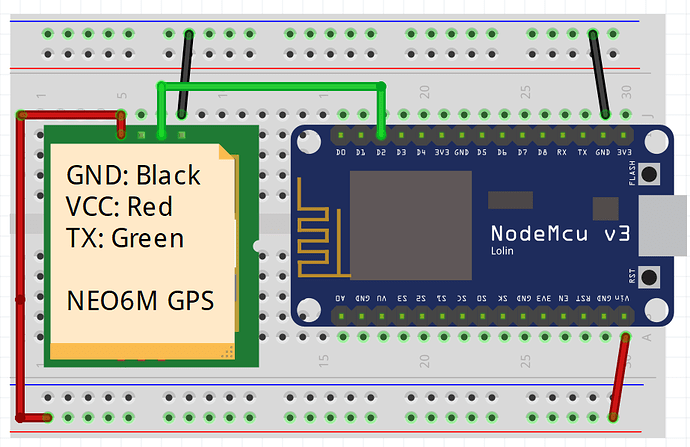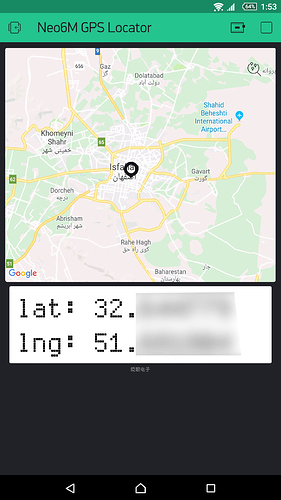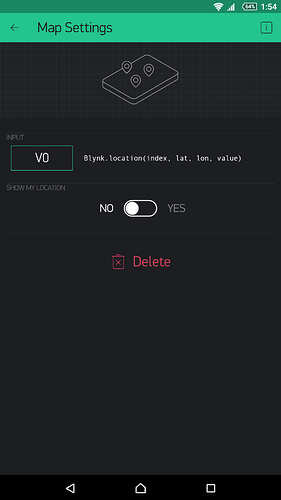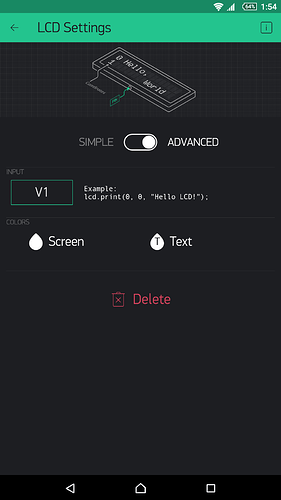Hi friends. here for those who want to locating the GPS position with Blynk from the hardware side.
Materials:
1x ESP8266 NodeMCU
1x NEO6M GPS module with antenna
3X male jumper wires
a usb cable to programming the NodeMCU
a Breadboard to placing the parts on it.
Wiring:
the Project:
Setting up Widgets:
MAP Widget setting
LCD Widget setting
######################################################################################
The Arduino Sketch:
/* ############## Libraries ############## */
#include <TinyGPS++.h>
#include <SoftwareSerial.h>
#include <SimpleTimer.h>
#include <ESP8266WiFi.h>
#include <BlynkSimpleEsp8266.h>
/* ############## Blynk Connection Setup ############## */
char auth[] = "your blynk token"; // Blynk authentication key
char ssid[] = "your wifi ssid"; // Name of your WiFi SSID
char pass[] = "your wifi password"; // WiFi Password
char server[] = "your local server ip address";
/* virtual pins:
# V0: MAP
# V1: LCD screen in Advanced
*/
// Blynk LCD and map widgets
WidgetLCD lcd(V1);
WidgetMap myMap(V0);
String GPSLabel = "BLYNK"; //Labeling location on MAP
/* ############## Timer ############## */
SimpleTimer timer;
/* ############## GPS PIN Setup ############## */
static const int RXPin = 4, TXPin = 5; // GPIO 4=D2(conneect Tx of GPS) and GPIO 5=D1(Connect Rx of GPS)
static const uint32_t GPSBaud = 9600; //if Baud rate 9600 didn't work in your case then use 4800
TinyGPSPlus gps; // The TinyGPS++ object
SoftwareSerial ss(RXPin, TXPin); // Serial connection to the GPS module
/* ############################
Starting Program
############################ */
void setup() {
Serial.begin(9600); // serial connection for debugging
ss.begin(GPSBaud);
//Connect Blynk
Blynk.begin(auth, ssid, pass, server, 8080);
Serial.println("Activating GPS");
timer.setInterval(1000L, periodicUpdate);
timer.setInterval(60*1000, reconnectBlynk);
}
//Show GPS lat and lng on LCD
void periodicUpdate() {
String line1, line2;
//LCD
lcd.clear();
if (gps.location.isValid() && (gps.location.age() < 3000)) {
//position current
line1 = String("lat: ") + String(gps.location.lat(), 6);
line2 = String("lng: ") + String(gps.location.lng(), 6);
lcd.print(0, 0, line1);
lcd.print(0, 1, line2);
//update location on map
myMap.location(2, gps.location.lat(), gps.location.lng(), GPSLabel);
} else {
//position is lost
lcd.print(0, 0, "GPS lost");
}
}
void updateGPS() {
//read data from GPS module
while (ss.available() > 0) {
gps.encode(ss.read());
}
}
void reconnectBlynk() {
if (!Blynk.connected()) {
Serial.println("Lost connection");
if(Blynk.connect()) Serial.println("Reconnected");
else Serial.println("Not reconnected");
}
}
void loop() {
timer.run();
if(Blynk.connected()) { Blynk.run(); }
updateGPS();
}


